The deserts of the American Southwest are famous for the many different types of plants that flourish in the hot and dry conditions. Perhaps the most iconic plant found in all three Southwestern deserts is the ocotillo. Although ocotillos are found growing naturally throughout the desert, they are also a welcome addition to residential and commercial landscapes, where their striking silhouette adds dramatic flair.
Often referred to as a type of cactus, ocotillos are actually a shrub. Multiple stems, called canes, grow upward from the base, adding a beautiful vertical accent to the landscape. Vermillion-colored flowers appear during the warm season, along with sporadic flushes of green leaves covering the canes in response to rain or increased humidity.
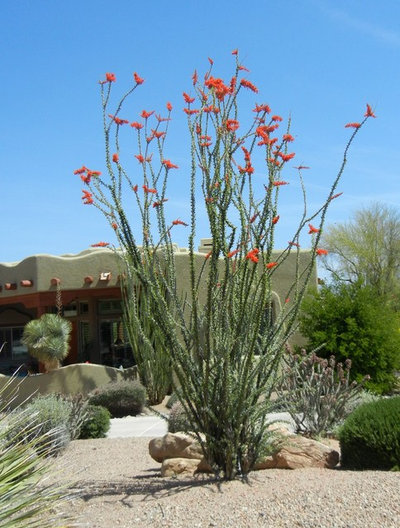
Noelle Johnson Landscape Consulting
Botanical name: Fouquieria splendensCommon name: Ocotillo
Origin: Native to the southwestern United States and Mexico
Where it will grow: Hardy to 10 degrees Fahrenheit (USDA zone 8; find your zone)
Water requirement: Low; water twice a month in summer to promote leafing out. In winter water every two months for the best appearance.
Light requirement: Full sun
Mature size: 10 feet wide and 15 feet tall
Benefits and tolerances: Drought tolerant once established; attracts hummingbirds when in flower
Seasonal interest: Vermillion-colored flowers appear in spring and summer.
When to plant: Fall or spring
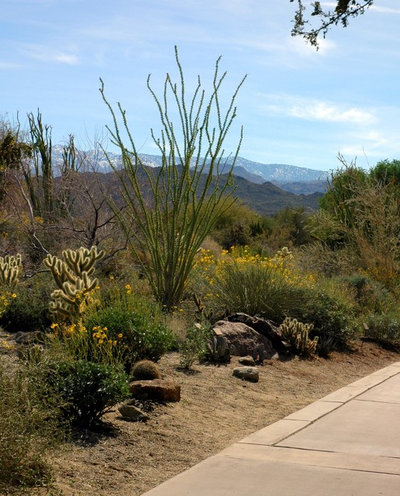
Noelle Johnson Landscape Consulting
Distinguishing traits. Drive through the Mojave, Sonoran or Chihuahuan deserts and you will see the graceful canes of ocotillos stretching up toward the desert sky.
Ocotillos are equally at home in Southwestern landscapes stretching from California to Texas and south into Mexico. Hardy to 10 degrees Fahrenheit, they thrive in full sun and rocky soil.
Shown: Ocotillos in the Sonoran Desert
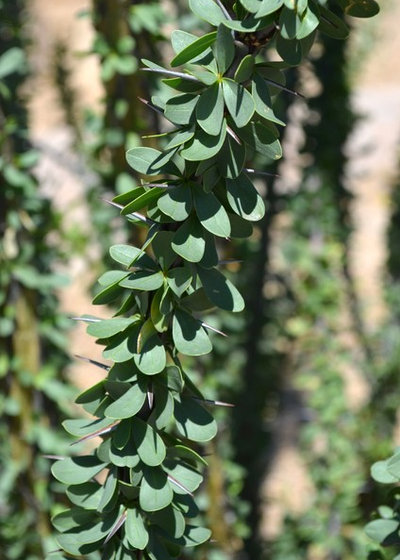
Noelle Johnson Landscape Consulting
The thorny canes of ocotillos are usually leafless in fall and winter. However, during the warmer months of spring and summer, ocotillos are transformed by the sporadic appearance of small green leaves that cover the canes of this multistemmed plant. The leaves often appear in response to rain or increased humidity.
The leaves will come and go throughout the spring and summer. Spraying the canes with water in spring and summer can help stimulate the canes to leaf out more often.
Shown: Thorny canes covered with small, green leaves
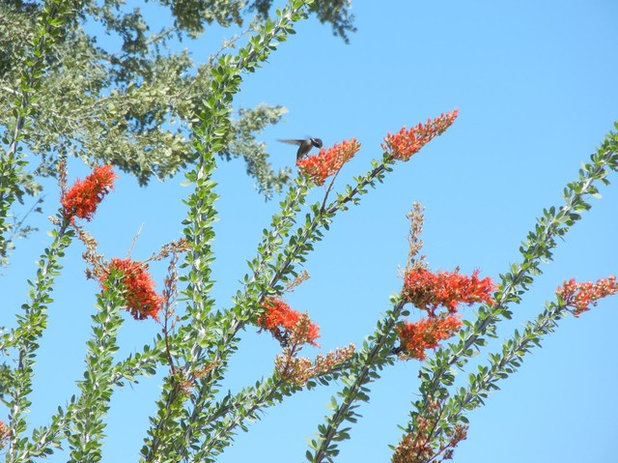
Noelle Johnson Landscape Consulting
In spring and early summer, reddish-orange flowers appear at the tips of the canes, adding bright color to the desert landscape. The flowers aren’t only beautiful; they are irresistible to hummingbirds.
Shown: A hummingbird feeding from ocotillo flowers
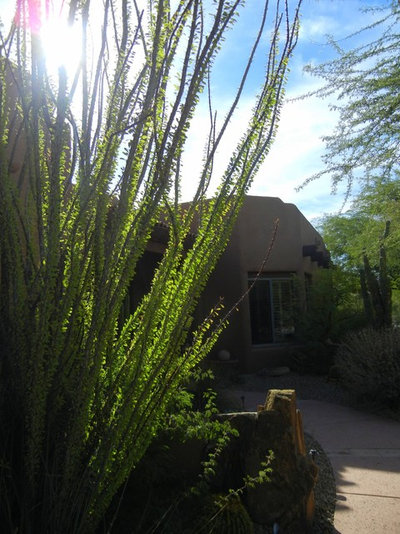
Noelle Johnson Landscape Consulting
How to use it. Plant ocotillo where you can view the beauty of its canes as they are backlit by the sunlight. Keep it away from areas near foot traffic to prevent anyone’s being pricked by the thorns.
Transform a bare wall by planting an ocotillo in front, where its graceful silhouette and shadow will add both texture and beauty to the landscape.
Shown: An ocotillo backlit by the rising sun
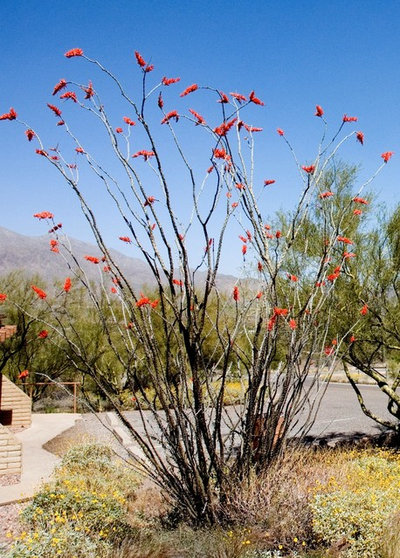
Noelle Johnson Landscape Consulting
Plant drought-tolerant ground covers such as
blackfoot daisy (
Melampodium leucanthum), damianita and
verbena (
Glandularia spp) around the base of your ocotillo. The ground covers’ flowers will add color at the ground level, while the ocotillo’s flowers will brighten up the sky.
Pair ocotillo with other desert natives such as
brittlebush (
Encelia farinosa)
and
pink fairy duster (
Calliandra eriophylla)
, whose water requirements are similar to the ocotillo.
Shown: A flowering ocotillo with leafless canes
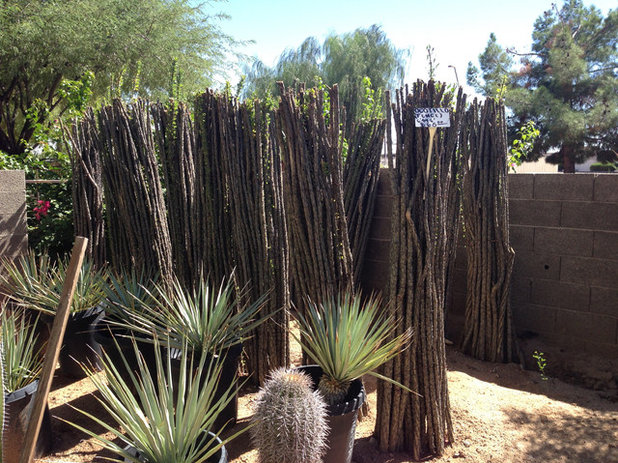
Noelle Johnson Landscape Consulting
You can also grow a living fence made up of multiple ocotillo canes planted in the ground.
Shown: Ocotillo canes for sale at a nursery, ready to be planted for use as a living fence
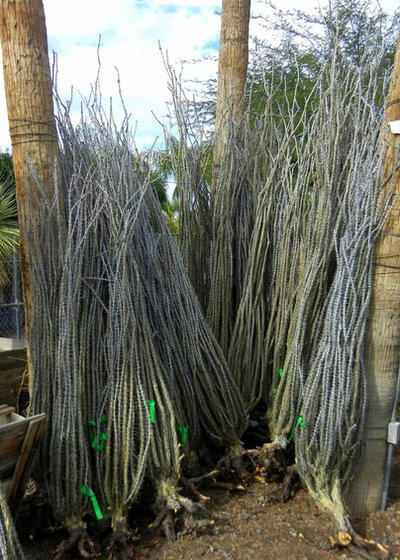
Noelle Johnson Landscape Consulting
Planting notes. Ocotillos are usually planted from bare-root transplants salvaged from the desert. Select the heaviest of the transplants; a heavy weight is an indication of a healthy ocotillo.
Nursery-grown ocotillos are becoming increasingly available; they have a higher success rate in the landscape. Both types can be planted in fall.
Ocotillo can take a couple of years to leaf out after being planted, so have a little patience.
Shown: Bare-root ocotillos
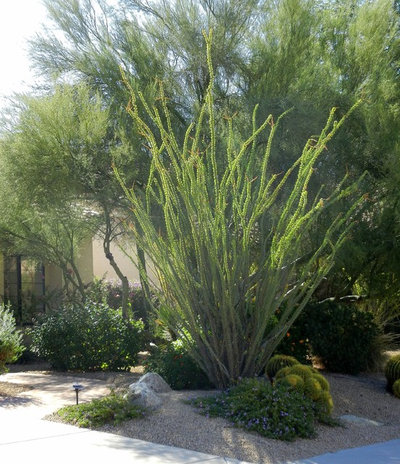
Noelle Johnson Landscape Consulting
Select a location for your ocotillo that receives full sun and has well-drained soil. Plant it slightly above the soil level to prevent the area around the roots from becoming waterlogged. Place other plants at least 3 feet away from the base to prevent the ocotillo from being overwatered.
A newly planted ocotillo will need to be watered once a week through the summer and then twice a month in the fall. Although established ocotillos can survive on rainfall alone, they look best if watered twice a month April through September. Water every other month October through March.
Shown: An ocotillo in a residential landscape





